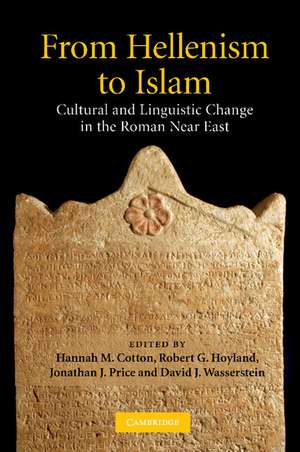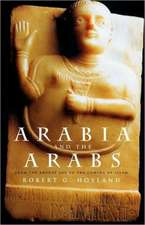From Hellenism to Islam: Cultural and Linguistic Change in the Roman Near East
Editat de Hannah M. Cotton, Robert G. Hoyland, Jonathan J. Price, David J. Wassersteinen Limba Engleză Paperback – 11 ian 2012
| Toate formatele și edițiile | Preț | Express |
|---|---|---|
| Paperback (1) | 450.69 lei 6-8 săpt. | |
| Cambridge University Press – 11 ian 2012 | 450.69 lei 6-8 săpt. | |
| Hardback (1) | 875.35 lei 6-8 săpt. | |
| Cambridge University Press – 2 sep 2009 | 875.35 lei 6-8 săpt. |
Preț: 450.69 lei
Nou
Puncte Express: 676
Preț estimativ în valută:
86.24€ • 90.27$ • 71.78£
86.24€ • 90.27$ • 71.78£
Carte tipărită la comandă
Livrare economică 31 martie-14 aprilie
Preluare comenzi: 021 569.72.76
Specificații
ISBN-13: 9781107403956
ISBN-10: 1107403952
Pagini: 512
Dimensiuni: 152 x 229 x 29 mm
Greutate: 0.74 kg
Editura: Cambridge University Press
Colecția Cambridge University Press
Locul publicării:New York, United States
ISBN-10: 1107403952
Pagini: 512
Dimensiuni: 152 x 229 x 29 mm
Greutate: 0.74 kg
Editura: Cambridge University Press
Colecția Cambridge University Press
Locul publicării:New York, United States
Cuprins
Introduction Fergus Millar; Part I. The Language of Power: Latin in the Roman Near East: 1. The presence, role and significance of Latin in the epigraphy and culture of the Roman Near East Werner Eck; 2. Latin in cities of the Roman Near East Benjamin Isaac; Part II. Social and Legal Institutions as Reflected in the Documentary Evidence: 3. Euergetism in Josephus and the epigraphic culture of first-century Jerusalem Seth Schwartz; 4. Legal and social status of threptoi and related categories in narrative and documentary sources Marijana Ricl; 5. Ritual performances of divine justice: the epigraphy of confession, atonement, and exaltation in Roman Asia Minor Angelos Chaniotis; 6. Continuity of Nabataean law in the Petra papyri: a methodological exercise Hannah M. Cotton; Part III. The Epigraphic Language of Religion: 7. 'Languages' and religion in second-fourth century Palestine. In search of the impact of Rome Nicole Belayche; 8. The epigraphic habit and the Jewish diasporas of Asia Minor and Syria Walter Ameling; 9. Religion and language in Dura-Europos Ted Kaizer; Part IV. Linguistic Metamorphoses and Continuity of Cultures: 10. On the margins of culture: the practice of transcription in the ancient world Jonathan Price and Shlomo Naeh; 11. Edessene Syriac inscriptions in late antique Syria Sebastian Brock; 12. Samaritan writing and writings Dan Barag; 13. The Jewish magical tradition from late antique Palestine to the Cairo Geniza Gideon Bohak; Part V. Greek into Arabic: 14. The Nabataean connection of the Benei Hezir Axel Knauf; 15. Greek inscriptions in transition from the Byzantine to the early Islamic period Leah Di Segni; 16. Arab kings, Arab tribes and the beginnings of Arab historical memory in late Roman epigraphy Robert Hoyland; 17. Greek, Coptic, and the 'language of the Hijra': rise and decline of the Coptic language in late antique and medieval Egypt Sebastian Richter; 18. 'What remains behind': Hellenism and Romanitas in Christian Egypt after the Arab conquest Arietta Papaconstantinou.
Descriere
This book considers how languages, peoples and cultures in the Near East interacted over the millennium between Alexander and Muhammad.














